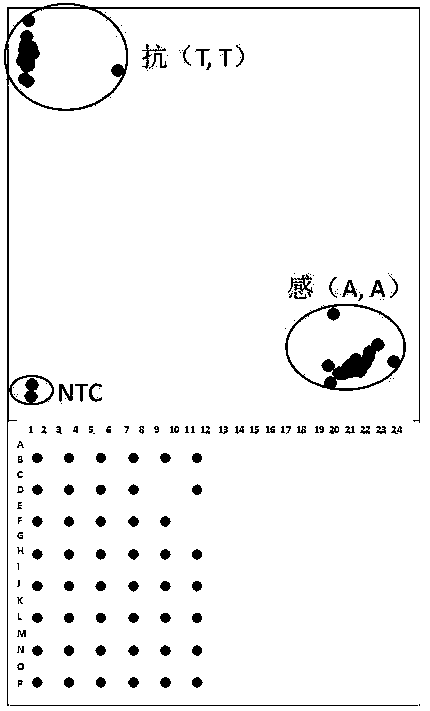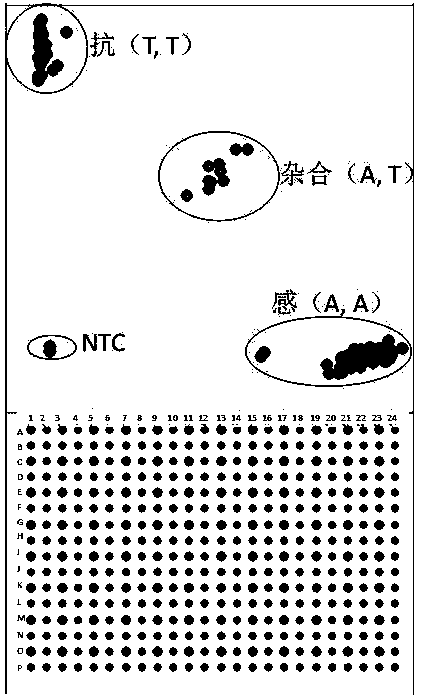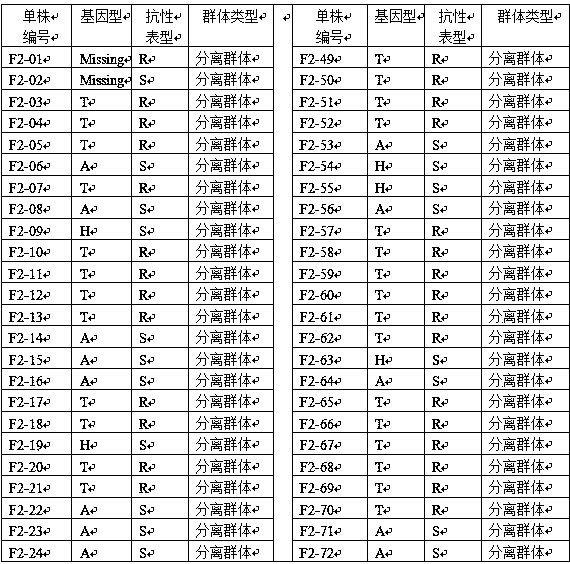SNP molecular marker for detecting rice stripe resistant disease genes STV11 and application
A technique for resistance to stripe blight and molecular markers, applied in the field of molecular biology, can solve the problems of low breeding efficiency, long breeding cycle for phenotypic identification, and complicated operation.
- Summary
- Abstract
- Description
- Claims
- Application Information
AI Technical Summary
Problems solved by technology
Method used
Image
Examples
Embodiment 1
[0056] The application of resistance gene-linked SNP marker K_180405 in natural population materials was verified by selecting 46 natural population materials, including 37 japonica and 9 indica.
[0057] 1. DNA extraction method:
[0058] The DNA of each variety (line) was extracted by CTAB method. Take the leaves at the seedling stage, grind them into powder with liquid nitrogen, and quickly transfer them into a 1.5 mL Eppendorf tube; add 800 μL of CTAB (1% w / v CTAB, 0.7 M NaCl, 10 mM EDT, 50 mMTris-HCl, pH8.0) Mix the extraction buffer, put it in a water bath at 65°C for 45 minutes, shake it gently every 10 minutes, centrifuge at 12000 rpm for 10 minutes; carefully absorb the supernatant, add an equal volume of chloroform, mix well, let it stand for stratification, 12000 rpm, centrifuge for 10 min; carefully absorb the supernatant, add an equal volume of isopropanol, and put it in a -20°C refrigerator for precipitation for more than 1 h. Centrifuge at 12000 rpm for 10 min...
Embodiment 2
[0066] Application of resistance gene-linked SNP marker K_180405 in segregated populations of breeding materials.
[0067] 1. Detect the genotype of a single plant in the F2 segregation population of the cross between the donor parent Nanjing 9108 and the recipient parent Jinjing 818, the method is the same as in Example 1.
[0068] 2. Carry out field resistance identification of rice stripe leaf blight on parents and individual plants of F2 segregation population, and determine the disease resistance level according to the incidence rate. The incidence rate of resistance (R) is less than 15%, and the incidence rate of sensitivity (S) is high at 15%.
[0069] The results of fluorescence scanning of 94 test materials are as follows: figure 2 As shown, the specific typing results of the markers are shown in Table 4.
[0070] Table 4 Testing and phenotypic verification of the marker K_180405 in Jinjing 818´Nanjing 9108 segregation population
[0071] Table 4 F2 segregation po...
PUM
 Login to View More
Login to View More Abstract
Description
Claims
Application Information
 Login to View More
Login to View More - R&D
- Intellectual Property
- Life Sciences
- Materials
- Tech Scout
- Unparalleled Data Quality
- Higher Quality Content
- 60% Fewer Hallucinations
Browse by: Latest US Patents, China's latest patents, Technical Efficacy Thesaurus, Application Domain, Technology Topic, Popular Technical Reports.
© 2025 PatSnap. All rights reserved.Legal|Privacy policy|Modern Slavery Act Transparency Statement|Sitemap|About US| Contact US: help@patsnap.com



